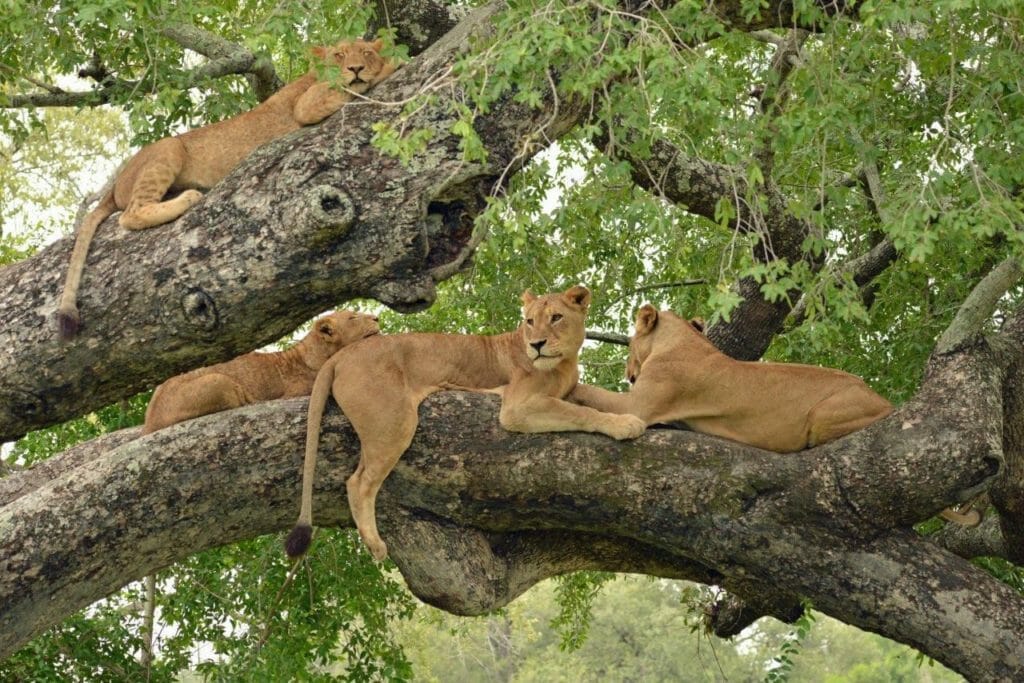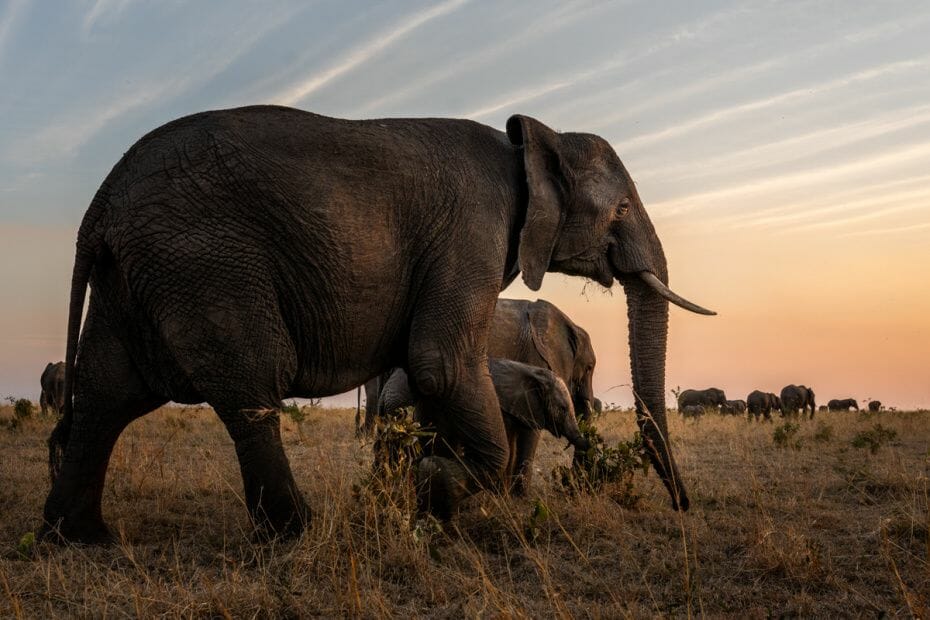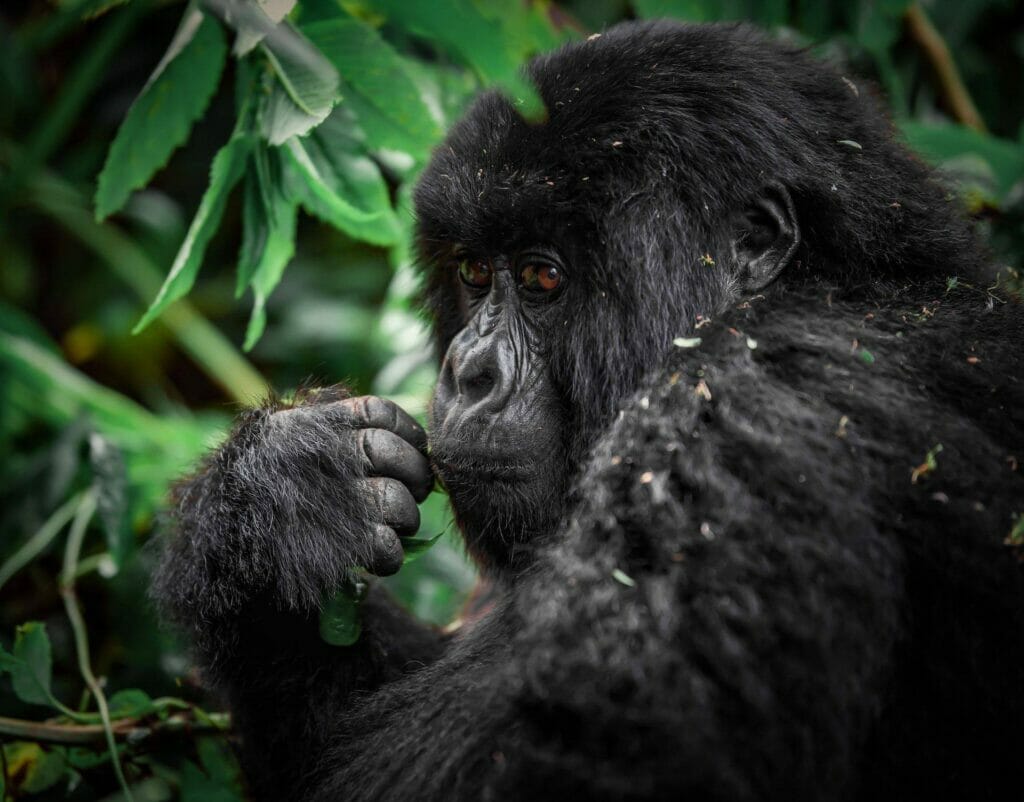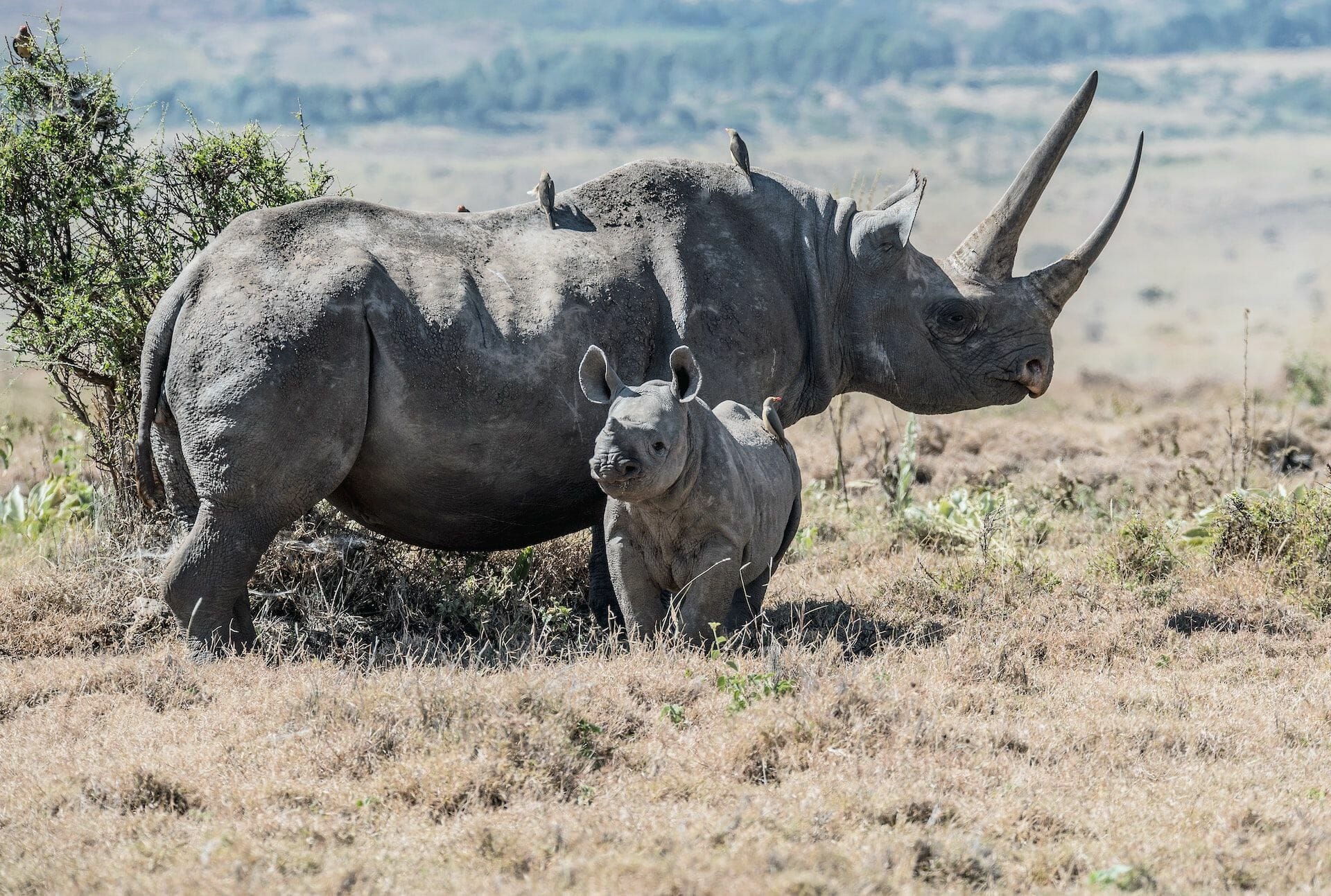East Africa Safari vs. Southern Africa Safari: How To Choose Your Next Adventure
Deciding between a Southern Africa safari and an East Africa safari is a choice that many first-time visitors to Africa face.
Both regions offer a wealth of natural wonders, from the sweeping savannas of the Serengeti in Tanzania to the lush forests of the Okavango Delta in Botswana.
However, there are also differences in terms of the types of wildlife you might see, the landscapes you’ll encounter, and the activities available to you.
Southern Africa, for instance, is known for its incredible diversity of wildlife, ranging from the Big Five (lion, leopard, elephant, buffalo, and rhino) to rare species like wild dogs and pangolins.
East Africa, on the other hand, is renowned for its annual wildebeest migration, as well as its stunning mountain gorillas and diverse birdlife.
Ultimately, the choice between these two regions comes down to what you hope to experience on your safari adventure. In the following sections, we’ll explore the benefits of each region in more detail, to help you make an informed decision.
East Africa Safaris Guide: The Wildlife, The Countries, The Cultures

East Africa is one of the most sought-after safari destinations in the world, and it’s not hard to see why (and yes, we are Uganda safari tour specialists, so we love our little corner of this continent!)
This region of the continent is home to some of the most iconic wildlife species on the planet, from the majestic lions and elephants to the rare mountain gorillas.
In addition to its wildlife, East Africa also boasts a rich cultural heritage, with diverse traditions and customs that have been preserved for centuries. In this section, we will explore the wildlife, countries, and culture of East Africa, so that you can get a better sense of what makes this region such a popular safari destination.
Where You’ll Go On An East Africa Safari
The 13 East African countries are Burundi, Comoros, Djibouti, Ethiopia, Eritrea, Kenya, Rwanda, Seychelles, Somalia, South Sudan, Sudan, Tanzania, and Uganda.
While they are all beautiful in their own ways, they are not all as developed yet for safaris. To help, we have broken down some of the most popular places to go on an East Africa safari:
- Kenya – Home to the Maasai Mara National Reserve, which is famous for its annual wildebeest migration, as well as Amboseli National Park, which is known for its large herds of elephants.
- Tanzania – One of the most iconic safari destinations in the world, Tanzania is home to the Serengeti National Park, which is home to the Big Five and hosts the annual wildebeest migration. Other popular destinations include the Ngorongoro Crater, which is a UNESCO World Heritage Site and the largest intact volcanic caldera in the world, and the Selous Game Reserve, which is one of the largest protected wildlife areas in Africa.
- Uganda – This small, landlocked country is known for its mountain gorillas, which can be found in the Bwindi Impenetrable Forest National Park and Mgahinga Gorilla National Park. Uganda is also home to a range of other primates, as well as diverse birdlife and stunning landscapes.
- Rwanda – Like Uganda, Rwanda is home to mountain gorillas, which can be seen in Volcanoes National Park. The country is also known for its beautiful scenery and welcoming people.
- Ethiopia – Though not as well-known as some of the other countries on this list, Ethiopia is a hidden gem for safari-goers. The Simien Mountains National Park is home to rare species like the gelada baboon and the Ethiopian wolf, while the Omo Valley offers a glimpse into traditional tribal life.
No matter which country you choose to visit, an East Africa safari is sure to be an unforgettable adventure.
Main Wildlife To See In East Africa
East Africa is home to some of the most iconic wildlife species in the world, and is particularly famous for the Big Five: lion, leopard, elephant, buffalo, and rhino.
These animals can be found in several East African countries, including Kenya, Tanzania, and Uganda. In fact, the Serengeti National Park in Tanzania is one of the best places in the world to see the Big Five in their natural habitat. Uganda also has the Big Five, including a sanctuary reserved just for walking safaris to see the white rhino!
However, East Africa is also home to a wide range of other wildlife species that cannot be found in Southern Africa. One such species is the mountain gorilla, which can only be found in the mountainous regions of Uganda, Rwanda, and the Democratic Republic of Congo.
Other primates that can be seen in East Africa include chimpanzees, colobus monkeys, and baboons.
Birdwatchers will also find plenty to enjoy on an East Africa safari, as the region is home to over 1,000 different bird species. Some of the most spectacular birds to see include the African fish eagle, the Lilac-breasted roller, and the ostrich.
Finally, it’s worth noting that East Africa is home to some of the world’s most spectacular landscapes, from the vast savannas of the Serengeti to the misty rainforests of Uganda. These landscapes are not only beautiful in their own right, but also provide habitats for a diverse array of wildlife.
Type of Culture in East Africa

East Africa is a region rich in culture and history, with a diverse array of tribes, languages, and customs. One of the most striking features of East African culture is the hospitality and warmth of its people towards visitors.
There are over 100 different ethnic groups in East Africa, each with their own unique customs and traditions. Some of the most prominent tribes include the Maasai of Kenya and Tanzania, known for their distinctive dress and traditional way of life as semi-nomadic pastoralists, and the Kikuyu of Kenya, who are the largest ethnic group in the country and are known for their farming and entrepreneurial spirit.
In terms of language, there are hundreds of different languages spoken in East Africa, although Swahili is one of the most widely spoken and is often used as a lingua franca across the region. English is also commonly spoken in many parts of East Africa, particularly in tourist areas.
Finally, as mentioned earlier, hospitality is a key aspect of East African culture, and visitors to the region are often struck by the warmth and friendliness of the local people. Many East Africans have a deep respect for visitors and are eager to share their culture and way of life with them.
Southern Africa Safaris Guide: The Wildlife, The Countries, The Cultures
Now let’s travel to Southern Africa, which includes Angola, Botswana, Lesotho, Malawi, Mozambique, Namibia, South Africa, Swaziland, Zambia, and Zimbabwe.
It’s a region that’s rich in biodiversity, with a wide variety of wildlife, landscapes, and cultures to explore. It’s often on people’s short list for their first Africa safari, and remains a popular destination for safari enthusiasts from around the world.
One of the key features of Southern Africa is its incredible wildlife, which includes the famous Big Five animals, as well as a range of other species such as wild dogs, cheetahs, and giraffes. In addition, the region is home to some of the world’s most breathtaking landscapes, from the deserts of Namibia to the wetlands of the Okavango Delta.
Overall, Southern Africa offers an unforgettable safari experience, with its incredible wildlife, stunning landscapes, and fascinating cultures.
Where You’ll Go On A Southern Africa Safari
Though Southern Africa as a region has a similar number of countries to East Africa, there are currently more safari opportunities available. Let’s take a look at some of the popular ones.
- South Africa – Home to several iconic national parks and reserves, including Kruger National Park, Sabi Sands Game Reserve, and Addo Elephant National Park.
- Botswana – Known for its pristine wilderness areas, particularly the Okavango Delta and Chobe National Park.
- Namibia – Famous for its stunning landscapes, including the Namib Desert and Etosha National Park.
- Zimbabwe – Home to some of the continent’s most breathtaking natural wonders, such as Victoria Falls and Hwange National Park.
- Zambia – Known for its excellent walking safaris and the famous South Luangwa National Park.
- Malawi – A lesser-known destination for safaris, but with some excellent wildlife areas such as Liwonde National Park and Majete Wildlife Reserve.
- Mozambique – A coastal country with a wealth of marine life, including whale sharks, dolphins, and turtles.
- Angola – Another lesser-known safari destination, but with some excellent national parks and reserves such as Quiçama National Park.
- Swaziland – A small country with a rich cultural heritage and several game reserves, including Hlane Royal National Park.
Main Wildlife To See In Southern Africa

One of the most popular requests for a Southern African safari is to see the Big 5, which refers to the five most iconic and sought-after species in Africa: lion, elephant, leopard, rhinoceros, and Cape buffalo. All five of these species can be found in several countries throughout Southern Africa, including South Africa, Botswana, Zimbabwe, and Zambia.
In addition to the Big 5, Southern Africa is home to a wealth of other wildlife, including cheetahs, wild dogs, giraffes, zebras, hippos, and crocodiles. One of the key differences between Southern and East Africa is the prevalence of certain species – for example, Southern Africa is home to the endangered African wild dog, which is much less common in East Africa.
Another unique feature of Southern Africa’s wildlife is the abundance of marine life along its coastline. Mozambique and South Africa are particularly known for their excellent diving and snorkeling opportunities, where visitors can spot a range of marine species including whale sharks, dolphins, and turtles.
Type of Culture in Southern Africa
Your safari in Southern Africa will certainly be full of landscapes and wildlife, but it’s the people you may remember most. Southern Africa is home to a rich and diverse cultural heritage, with a number of distinct tribes, languages, and traditions. Here’s a brief overview:
- Zulu – One of the largest ethnic groups in South Africa, the Zulu are known for their vibrant cultural traditions, including music, dance, and storytelling.
- San – Also known as Bushmen, the San people are indigenous to Southern Africa and have a unique hunter-gatherer culture that has persisted for thousands of years.
- Xhosa – Another large ethnic group in South Africa, the Xhosa people are known for their intricate beadwork and colorful clothing.
- Himba – An indigenous tribe in Namibia, the Himba people are known for their distinctive red ochre body paint and intricate hairstyles.
- Ndebele – A Bantu ethnic group in South Africa and Zimbabwe, the Ndebele are known for their colorful geometric murals and beadwork.
Southern Africa has an incredibly diverse selection of languages, too, with dozens spoken throughout the region. Some of the most widely spoken languages include Zulu, Xhosa, Afrikaans, and English.
It’s also an area known for its warm and welcoming culture, with locals often eager to share their traditions and customs with visitors. Many lodges and resorts in the region offer cultural experiences, such as traditional dances and meals, giving travelers the opportunity to learn more about the local culture.
Pros and Cons of an East Africa Safari

It’s not always to make a decision about where to go for your first African safari. Let’s start with the pros and cons of an East Africa safari.
The Pros of East Africa Safaris
- High concentration of wildlife – East Africa is home to some of the most iconic wildlife on the planet, including the Big Five (lions, elephants, leopards, rhinos, and buffalo). The concentration of wildlife in many of the region’s national parks and game reserves is incredibly high, making it an ideal destination for wildlife enthusiasts.
- Cultural experiences – East Africa is home to a rich and diverse array of cultures, and many lodges and tour operators offer cultural experiences that allow visitors to learn about traditional ways of life, interact with local communities, and gain a deeper understanding of the region’s history and customs.
- Scenic beauty – From the savannahs of the Serengeti to the snow-capped peaks of Mount Kilimanjaro, East Africa is home to some of the most stunning landscapes in the world. Whether you’re exploring a national park or hiking through a remote wilderness area, the scenery in East Africa is sure to take your breath away.
The Cons of East Africa Safaris
- Crowds – East Africa is a popular destination for safari-goers, and some of the region’s most famous national parks and game reserves can get very crowded during peak season, especially if you’re considering going to the Great Migration in Tanzania and Kenya. If you’re looking for a more remote and secluded experience, you may want to consider a safari in a more undiscovered area in East Africa, like Uganda or Rwanda.
- Expense – East Africa is generally more expensive than other safari destinations, due in part to its remoteness and the cost of vehicles to get from place to place. If you’re on a budget, you may want to consider a safari in Southern Africa, which can be more affordable.
- Limited access to certain areas – While East Africa is home to some of the most iconic wildlife destinations in the world, certain areas may be off-limits due to rainy weather, poor roads, or other factors.
Pros and Cons of a Southern Africa Safari
The Pros of Southern Africa Safaris:
- Diversity of landscapes and wildlife – Southern Africa offers a wide range of landscapes and wildlife, from the rugged coastline of South Africa to the vast wilderness of Botswana’s Okavango Delta. Visitors can see the Big Five as well as other unique species such as meerkats, wild dogs, and penguins.
- Affordability – Compared to East Africa, Southern Africa is generally more affordable. There are plenty of budget-friendly options available, including self-drive safaris and camping trips.
- Accessibility – Many of Southern Africa’s top safari destinations, such as Kruger National Park and the Okavango Delta, are easily accessible and well-established. This makes it a great option for first-time safari-goers who may be hesitant about traveling to more remote or unfamiliar destinations.
The Cons of Southern Africa Safaris:
- Crowds – Like certain countries in East Africa, some of Southern Africa’s most popular safari destinations can get very crowded during peak season. Visitors may want to consider visiting during the shoulder season or exploring lesser-known areas to avoid the crowds.
- Limited cultural experiences – While Southern Africa has a rich and diverse cultural heritage, many of its top safari destinations are primarily focused on wildlife viewing. Visitors who are interested in learning about local cultures may need to seek out specific experiences or destinations.
- Limited access to certain species – While Southern Africa offers a wealth of wildlife viewing opportunities, there are certain species that are more commonly found in East Africa. For example, mountain gorillas can only be found in Uganda, Rwanda, and the Democratic Republic of Congo.
Book Your Next Uganda Safari Tour With Kikooko Africa Safaris
If you’re ready to experience everything that East Africa has to offer on a safari tour, look no further than Uganda! With its diverse landscapes, abundant wildlife, and rich cultural heritage, Uganda is the perfect destination for travelers looking for an immersive and unforgettable safari experience.
And when it comes to planning your Uganda safari tour, Kikooko Africa Tours is the right choice. We offer fully customizable tours that are tailored to your specific interests and preferences, allowing you to create the safari adventure of your dreams.
Whether you’re interested in gorilla trekking, wildlife safaris, cultural experiences, or all of the above, our team of experienced guides and travel experts will work with you to create the perfect itinerary. With our attention to detail and commitment to providing the highest level of service, you can rest assured that your Uganda safari tour with Kikooko Africa Tours will be an experience you’ll never forget.
So what are you waiting for? Contact us today to start planning your East Africa adventure!




